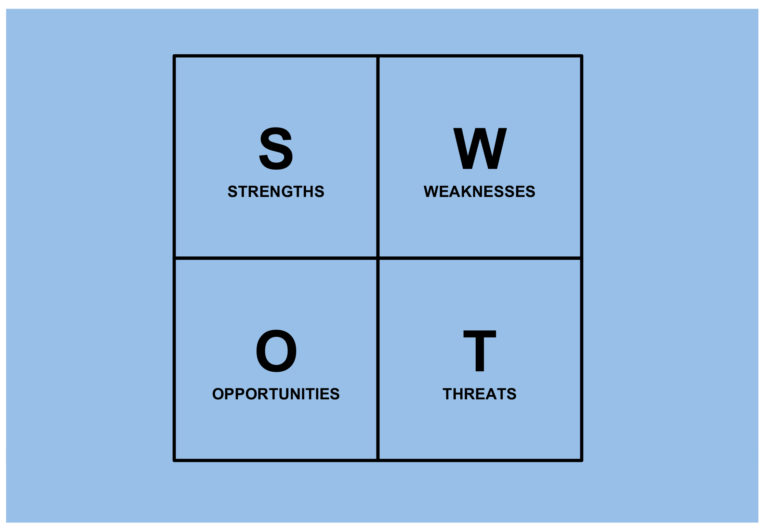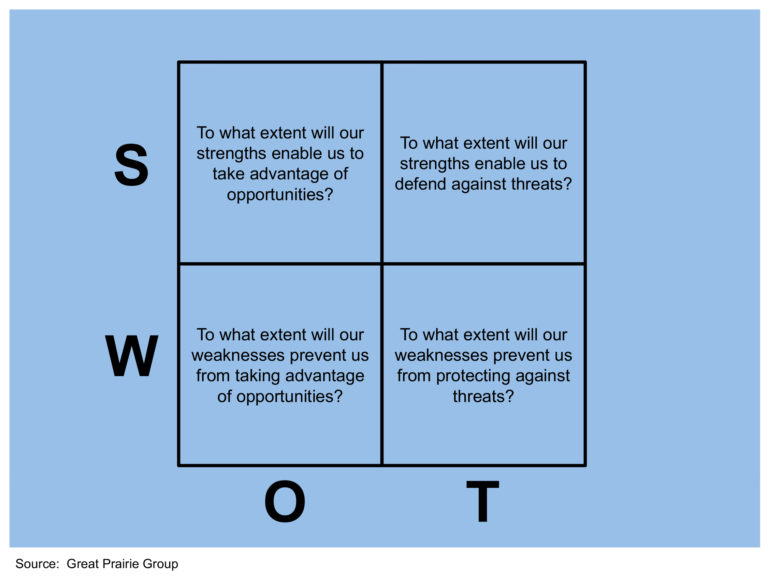SWOT Analysis is a core tool of the strategic planning process. Its purpose is to identify a company’s strengths, weaknesses, opportunities and threats. In its basic form, it may appear trivial and limited. A more advanced form of SWOT Analysis, however, can lead to significant strategic insight and offer more value than meets the eye.
THE BASICS OF SWOT ANALYSIS
SWOT represents strengths, weaknesses, opportunities and threats. The SWOT analysis matrix helps to identify what a company does well, what it needs to improve, external opportunities that it may want to capture, and external threats that could present serious challenges to the business (Figure1).
Figure 1. The SWOT Analysis Matrix

To complete a SWOT analysis, a company team focused on a particular purpose goes through a disciplined group discussion to arrive at a set of company strengths, weaknesses, opportunities, and threats. With this information, the team then sets out to map a plan of action that maximizes strengths and opportunities and minimizes weaknesses and threats. Typically the team stops here, and this becomes the extent of the exercise
THE LIMITATIONS
Admittedly this form of SWOT Analysis presents limitations. This approach lacks teeth as it doesn’t push the thinking far enough. Statements of strengths, weaknesses, opportunities and threats can be subjective and aspirational in nature, without any internal test of robustness, practicality or a real advantage.
The strategic insights derived from this level of analysis can remain superficial and never get to the core of the issues. In fact, this form SWOT Analysis could easily blindside the company in a few ways:
- Underestimating its true capacity to deal weaknesses and threats, and
- Overestimating its strengths in taking advantage of opportunities
- Mis-calibrating true critical issues
Because the group exercise can be cumbersome and offer limited benefit in getting to crucial strategy execution issues, not surprisingly, many teams have grown disaffected with SWOT Analysis.
CONFRONTATION ANALYSIS: QUESTIONS THAT GENERATE VALUE
In reality, there is more to SWOT Analysis than meets the eye. A few questions can inform us with valuable insight:
- To what extent will our strengths enable us to take advantage of opportunities? Defend against threats?
- To what extent will our company’s weaknesses keep us from taking advantage of opportunities? Defending against threats?
- How likely are we going to be able to take advantage of opportunities? Do we have what it takes or are we short somewhere?
- How likely are we going to be able to protect against threats? Do we have what it takes or are we exposed to vulnerabilities in our position?
Known as Confrontation Analysis, this line of analysis presents a different orientation of enquiry from the basic form of SWOT Analysis. Here, questions are designed to confront and measure Strengths and Weaknesses against Opportunities and Threats (Figure 2).
Figure 2. The Confrontation Analysis Matrix

The merit of this line of enquiry is that it provides three important measures of quality of analysis: relevance, focus on a closed bounded problem, and consistency.
First, Confrontation Analysis ensures relevance. Strengths are relevant only if they contribute or detract from taking advantage of opportunities or defending against threats. If they don’t, they become irrelevant. Similarly, weaknesses are relevant only insofar as they contribute or detract from opportunities or threats.
Second, Confrontation Analysis focuses the analysis on a closed bounded problem. The problem is defined by the opportunities and threats faced by the company. Strengths and weaknesses must be relevant to the problem to count in the analysis. Therefore, not all strengths and weaknesses make the cut. Those strengths and weaknesses that are irrelevant or aspirational get eliminated from the discussion early on.
Third, Confrontation Analysis forces rigor and consistency. Examining strengths and weaknesses against opportunities and threats forces rigor and consistency in the approach, both in the analysis and in the final evaluation.
CONCLUSIONS
If the hallmark of the strategic planning process is actionable insight, Confrontation Analysis is a strategic planning tool that offers exactly that: it triggers focused analytical thinking. The analysis can be challenging, but extremely valuable.
- It requires confronting strategic aspirations with the realities of the market and the competition
- It focuses the team on opportunities and threats against relevant strengths and weaknesses in the pursuit of strategic objectives
- It puts the core issues of strategy execution squarely in the cross hairs of the analysis
- Finally, not only does the approach force the team to confront its assumptions, but
- It also helps the team to converge quickly on solutions that are practical and immediate
In our experience, the most successful organizations in strategy execution adopt Confrontation Analysis in their strategic planning process as a more practical and more rigorous form of SWOT Analysis. Answering the set of four questions described in this article will increase the odds of a happy outcome.

